Rab6 regulates both ZW10/RINT-1 and conserved oligomeric Golgi complex-dependent Golgi trafficking and homeostasis
- PMID: 17699596
- PMCID: PMC1995728
- DOI: 10.1091/mbc.e07-01-0080
Rab6 regulates both ZW10/RINT-1 and conserved oligomeric Golgi complex-dependent Golgi trafficking and homeostasis
Abstract
We used multiple approaches to investigate the role of Rab6 relative to Zeste White 10 (ZW10), a mitotic checkpoint protein implicated in Golgi/endoplasmic reticulum (ER) trafficking/transport, and conserved oligomeric Golgi (COG) complex, a putative tether in retrograde, intra-Golgi trafficking. ZW10 depletion resulted in a central, disconnected cluster of Golgi elements and inhibition of ERGIC53 and Golgi enzyme recycling to ER. Small interfering RNA (siRNA) against RINT-1, a protein linker between ZW10 and the ER soluble N-ethylmaleimide-sensitive factor attachment protein receptor, syntaxin 18, produced similar Golgi disruption. COG3 depletion fragmented the Golgi and produced vesicles; vesicle formation was unaffected by codepletion of ZW10 along with COG, suggesting ZW10 and COG act separately. Rab6 depletion did not significantly affect Golgi ribbon organization. Epistatic depletion of Rab6 inhibited the Golgi-disruptive effects of ZW10/RINT-1 siRNA or COG inactivation by siRNA or antibodies. Dominant-negative expression of guanosine diphosphate-Rab6 suppressed ZW10 knockdown induced-Golgi disruption. No cross-talk was observed between Rab6 and endosomal Rab5, and Rab6 depletion failed to suppress p115 (anterograde tether) knockdown-induced Golgi disruption. Dominant-negative expression of a C-terminal fragment of Bicaudal D, a linker between Rab6 and dynactin/dynein, suppressed ZW10, but not COG, knockdown-induced Golgi disruption. We conclude that Rab6 regulates distinct Golgi trafficking pathways involving two separate protein complexes: ZW10/RINT-1 and COG.
Figures
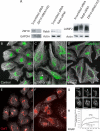
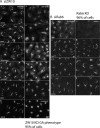


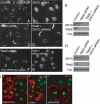

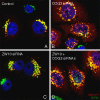



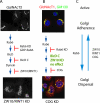
Similar articles
-
Distinct sets of Rab6 effectors contribute to ZW10--and COG-dependent Golgi homeostasis.Traffic. 2014 Jun;15(6):630-47. doi: 10.1111/tra.12167. Epub 2014 Apr 11. Traffic. 2014. PMID: 24575842 Free PMC article.
-
Rab33b and Rab6 are functionally overlapping regulators of Golgi homeostasis and trafficking.Traffic. 2010 May;11(5):626-36. doi: 10.1111/j.1600-0854.2010.01051.x. Epub 2010 Feb 15. Traffic. 2010. PMID: 20163571
-
A new role for RINT-1 in SNARE complex assembly at the trans-Golgi network in coordination with the COG complex.Mol Biol Cell. 2013 Sep;24(18):2907-17. doi: 10.1091/mbc.E13-01-0014. Epub 2013 Jul 24. Mol Biol Cell. 2013. PMID: 23885118 Free PMC article.
-
How Rab proteins determine Golgi structure.Int Rev Cell Mol Biol. 2015;315:1-22. doi: 10.1016/bs.ircmb.2014.12.002. Epub 2015 Feb 7. Int Rev Cell Mol Biol. 2015. PMID: 25708460 Free PMC article. Review.
-
Structural aspects of Rab6-effector complexes.Biochem Soc Trans. 2009 Oct;37(Pt 5):1037-41. doi: 10.1042/BST0371037. Biochem Soc Trans. 2009. PMID: 19754447 Review.
Cited by
-
Unraveling the Golgi ribbon.Traffic. 2010 Nov;11(11):1391-400. doi: 10.1111/j.1600-0854.2010.01114.x. Traffic. 2010. PMID: 21040294 Free PMC article. Review.
-
Are Rab proteins the link between Golgi organization and membrane trafficking?Cell Mol Life Sci. 2012 Dec;69(24):4093-106. doi: 10.1007/s00018-012-1021-6. Epub 2012 May 13. Cell Mol Life Sci. 2012. PMID: 22581368 Free PMC article. Review.
-
C11ORF24 is a novel type I membrane protein that cycles between the Golgi apparatus and the plasma membrane in Rab6-positive vesicles.PLoS One. 2013 Dec 2;8(12):e82223. doi: 10.1371/journal.pone.0082223. eCollection 2013. PLoS One. 2013. PMID: 24312644 Free PMC article.
-
New links between vesicle coats and Rab-mediated vesicle targeting.Semin Cell Dev Biol. 2011 Feb;22(1):18-26. doi: 10.1016/j.semcdb.2010.07.003. Epub 2010 Jul 17. Semin Cell Dev Biol. 2011. PMID: 20643221 Free PMC article. Review.
-
Electron tomography reveals Rab6 is essential to the trafficking of trans-Golgi clathrin and COPI-coated vesicles and the maintenance of Golgi cisternal number.Traffic. 2012 May;13(5):727-44. doi: 10.1111/j.1600-0854.2012.01343.x. Epub 2012 Mar 14. Traffic. 2012. PMID: 22335553 Free PMC article.
References
-
- Allan B. B., Moyer B. D., Balch W. E. Rab1 recruitment of p115 into a cis-SNARE complex: programming budding COPII vesicles for fusion. Science. 2000;289:444–448. - PubMed
-
- Andag U., Schmitt H. H. Dsl1p, an essential component of the Golgi-endoplasmic reticulum retrieval system in yeast, uses the same sequence motif to interact with different subunits of the COPI vesicle coat. J. Biol. Chem. 2003;278:51722–51734. - PubMed
-
- Antony C., Cibert C., Geraud G., Santa Maria A., Maro B., Mayau V., Goud B. The small GTP-binding protein rab6p is distributed from medial Golgi to the traan-Golgi network as determined by a confocal microscopic approach. J. Cell Sci. 1992;103:785–796. - PubMed
Publication types
MeSH terms
Substances
LinkOut - more resources
Full Text Sources

